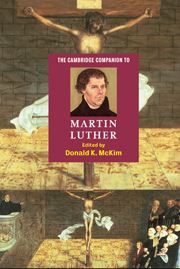13 - Luther’s function in an age of confessionalization
from Part III - After Luther
Published online by Cambridge University Press: 28 May 2006
Summary
Like a storm wind, the words and images of Martin Luther swept across early sixteenth-century central Europe, decisively altering public life in German, Scandinavian, and Baltic lands, and even among peoples in Slovakia, Hungary, and Poland, where the Counter-Reformation later diminished his influence considerably. Luther's enemies viewed the currents aroused by his writings and his popularity among common folk and intellectuals as demonically destructive; his supporters experienced them as divine intervention for a beleaguered society and a tyrannized church.
THE ANGEL OF THE APOCALYPSE, THE GERMAN HERCULES – TEACHER AND PASTOR
Historical personages always take on a new life in the traditions that convey their personalities and thought to succeeding generations. Twentiethcentury scholars sometimes complained that the images of Luther and the summaries of his theology which have helped shape Western culture and Christian thinking do not accurately reflect the “real” reformer, but such is always true. Intensifying this commonplace in Luther’s case is the fact that already during his lifetime his contemporaries experienced him as “larger than life.”
- Type
- Chapter
- Information
- The Cambridge Companion to Martin Luther , pp. 209 - 226Publisher: Cambridge University PressPrint publication year: 2003
- 1
- Cited by

